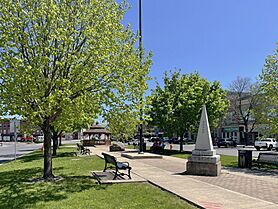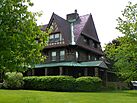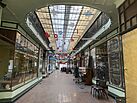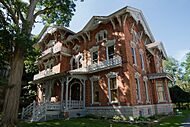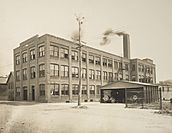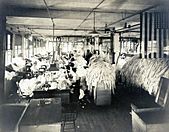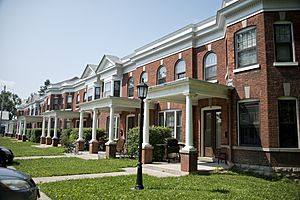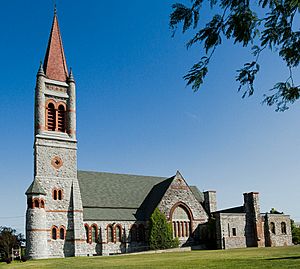Watertown, New York facts for kids
Quick facts for kids
Watertown
|
||
|---|---|---|
|
Clockwise from top: the Public Square; the St. Paul's Episcopal Church, the Emma Flower Taylor Mansion; the Paddock Arcade; a set of buildings including the Paddock Arcade; the Roswell P. Flower Memorial Library; the Paddock Mansion; the Jefferson County Courthouse Complex; the Black River.
|
||
|
||
| Nickname(s):
The Garland City
|
||
| Country | United States | |
| State | New York | |
| County | Jefferson | |
| Region | North Country | |
| Settled | 1800 | |
| Incorporated (village) | 1816 | |
| Incorporated (city) | 1869 | |
| Government | ||
| • Type | Council-Manager | |
| Area | ||
| • Total | 9.39 sq mi (24.31 km2) | |
| • Land | 9.03 sq mi (23.39 km2) | |
| • Water | 0.35 sq mi (0.92 km2) | |
| Elevation | 466 ft (142 m) | |
| Population
(2020)
|
||
| • Total | 24,685 | |
| • Density | 2,733.06/sq mi (1,055.21/km2) | |
| Demonym(s) | Watertownian | |
| Time zone | UTC−5 (EST) | |
| • Summer (DST) | UTC−4 (EDT) | |
| Zip Codes |
13601, 13602
|
|
| Area code(s) | 315 | |
| FIPS code | 36-78608 | |
| GNIS feature ID | 0968914 | |
Watertown is a city in New York, and it's the main city of Jefferson County. It's located about 25 miles (40 km) south of the Thousand Islands and sits along the Black River. The river flows into Lake Ontario about 5 miles (8 km) to the west.
Watertown is surrounded by the town of Watertown on its south, east, and west sides. The city has its own airport, the Watertown International Airport, and a local newspaper, the Watertown Daily Times. In the heart of Watertown is the Public Square Historic District, which was created in 1805. This area is so important that it was added to the National Register of Historic Places in 1984.
Watertown is also a key place for people living near the U.S. Army base at Fort Drum, which is about 13 miles (21 km) southwest. Many soldiers and their families come to Watertown for shopping and services. In 2020, the city had 24,685 residents, making it the biggest city in the North Country region of New York.
The area was first explored in 1795 and settled in March 1800. This was because the Black River offered a lot of hydropower, which is energy from flowing water. Watertown became the county seat of Jefferson County in 1805. It was first set up as a village in 1816 and then became a city in 1869. At that time, it was a busy industrial hub in Upstate New York. By the early 1900s, it was even said to have many wealthy people. However, in the mid-1960s, many young people and businesses moved away, causing some historic buildings to be torn down and the population to shrink. By 2000, the city had lost over 7,000 residents.
Today, Watertown is an important center for business and money in the North Country. It's only about 30 miles (48 km) from the Canadian border, so many Canadian visitors come to shop, which helps the local economy. The city also welcomes many tourists and people who spend their summers there.
Contents
Discover Watertown's Past
How Watertown Got Its Name
Watertown got its name because it sits right on the Black River. No one knows for sure who picked the name, but people believe it was chosen to attract mills. Mills use water power to grind grain or make other products. By 1850, many different types of mills, all powered by the Black River, were being built throughout Watertown.
Early Days and Growth

In 1791, a New York City merchant named Alexander Macomb bought a large area of land. This land included what is now Jefferson, Lewis, St. Lawrence, and Oswego counties. He hired surveyors to sell the land to settlers. The Watertown area was first surveyed in 1796 by Benjamin Wright.
In 1798, pioneers like Hart Massey, Henry Coffeen, and Zachariah Butterfield built cabins in the area that is now Public Square. They were part of a big move of people from New England after the Revolutionary War. The land was very uneven, so it was leveled out in one of the first landfill projects in the United States. In 1800, this area became part of Watertown.
Henry Coffeen and other early settlers chose this spot because of the Black River. It flowed west into Lake Ontario about 5 miles (8 km) away. They dreamed of building an industrial center that would use the river's power. In 1805, settlers cleared the center of town to create Public Square. Many important buildings were built around it during the 1800s. This area is now a historic district and is listed on the National Register of Historic Places.
Watertown became the main city for Jefferson County after it was separated from Oneida County. At that time, Watertown was one of the least populated places in the county. Watertown officially became a village in 1816 and then a city in 1869.
Because it was close to Lake Ontario, Watertown became a good place for moving supplies into Canada, which helped its economy. As businesses grew, successful residents built impressive shops, churches, and homes near the square. However, when the Embargo Act of 1807 stopped trade with Britain and France (which included Canada), the economy suffered. This eventually led to goods being smuggled into Canada and contributed to the War of 1812. During the American Civil War, the 35th New York Infantry Regiment started in Watertown.
The Paddock Arcade, built in 1850, is the oldest continuously open indoor mall in the United States. It's also on the National Register of Historic Places, along with several mansions and churches, like the Emma Flower Taylor Mansion and the Trinity Episcopal Church. The Black River drops 40 feet (12 m) in the center of town and 120 feet (37 m) over 2.5 miles (4.0 km). This provided a lot of water power for early industries.
By the mid-1800s, business owners had built paper mills and other big industries. One factory even made the first portable steam engine in 1847. In the late 1940s, many Irish people moved to Watertown during a time of great hunger in Ireland. In 1849, a fire in Public Square destroyed most of the buildings around it. In 1851, the city was connected by the Rome, Watertown and Ogdensburg Railroad to other major cities like Albany, Syracuse, and Rochester. More mills were added, bringing in money for public projects like a water system and gas lighting in 1853, and a telephone system in 1879.
Watertown claims that Rodman native Frank W. Woolworth got the idea for his famous Woolworth stores while working here in 1878. Woolworth, who was a clerk, had success selling low-priced items. This gave him the idea for a store that sold many different things at a fixed, low price. Woolworth left Watertown and opened his first store in 1879 in Utica. The Davis Sewing Machine Company, which later became Huffy, a bicycle maker, also started in Watertown.
In the late 1890s, many new factories and businesses opened. This caused the population to grow by over 17,000 people in 30 years. Watertown also developed a group of educated professionals like doctors and lawyers. In 1920, the city started using a city manager system of government.
After the Wall Street Crash of 1929, many stores closed and people lost their jobs, causing economic hardship. Things improved during World War II when Watertown's factories started making supplies for the war.
Modern Watertown History
Little Trees, the car air fresheners, were invented in Watertown in 1951. The company that makes them, Car-Freshner Corporation, has its main office and factory in the city. In the 1960s and 1970s, Watertown saw a decline in its industries. Many historic buildings, like the Hotel Woodruff, were torn down. Watertown's economy and population decreased. By the 1980s, unemployment in the area was as high as 20 percent.
In the 21st century, Watertown serves as a central point for the surrounding rural area. In 2006, the city started a $7.4 million project to restore buildings and fix roads and sidewalks. This project finished in 2008, and more improvements are planned. In early 2019, Watertown was called "The Least Politically Prejudiced Place in America" by Amanda Ripley.
Watertown's Location and Weather
Watertown is about 60 miles (97 km) northwest of Syracuse, 20 miles (32 km) south of the Thousand Islands, and 328 miles (528 km) northwest of New York City. The city covers about 9.3 square miles (24 km²), with 9.0 square miles (23 km²) of land and 0.3 square miles (0.78 km²) of water. Before it was settled, the land was rough and covered in forests. The Black River, which flows west through the city towards Lake Ontario, is famous for kayaking. Kayaking competitions, like the Blackwater Challenge, have been held on the river.
Climate and Seasons
Watertown has a climate with cold, snowy winters and mild to warm summers. On average, temperatures stay at or below freezing for 54 days each year. It gets very cold, dropping to 0°F (-18°C) or lower about 20 nights a year. The lowest temperature ever recorded was -39°F (-39°C) on December 29, 1933. Summers are usually mild, with temperatures reaching 90°F (32°C) or higher only about 3.1 days a year. The highest temperature ever recorded was 99°F (37°C) on July 20 and 27, 1894.
Watertown gets about 44.36 inches (112.7 cm) of rain and snow each year. The precipitation is spread out, but there's a bit more in the autumn. Because Watertown is near Lake Ontario, it gets a lot of lake-effect snow, averaging 116.4 inches (296 cm) of snowfall in the winter.
| Climate data for Watertown, New York | |||||||||||||
|---|---|---|---|---|---|---|---|---|---|---|---|---|---|
| Month | Jan | Feb | Mar | Apr | May | Jun | Jul | Aug | Sep | Oct | Nov | Dec | Year |
| Record high °F (°C) | 66 (19) |
67 (19) |
82 (28) |
92 (33) |
92 (33) |
98 (37) |
99 (37) |
97 (36) |
96 (36) |
87 (31) |
78 (26) |
69 (21) |
99 (37) |
| Mean daily maximum °F (°C) | 28.9 (−1.7) |
30.9 (−0.6) |
39.6 (4.2) |
53.5 (11.9) |
66.9 (19.4) |
75.3 (24.1) |
79.8 (26.6) |
78.7 (25.9) |
71.8 (22.1) |
58.6 (14.8) |
46.4 (8.0) |
34.9 (1.6) |
55.4 (13.0) |
| Mean daily minimum °F (°C) | 10.7 (−11.8) |
11.7 (−11.3) |
21.6 (−5.8) |
34.5 (1.4) |
47.2 (8.4) |
56.9 (13.8) |
62.0 (16.7) |
60.5 (15.8) |
52.3 (11.3) |
41.0 (5.0) |
30.5 (−0.8) |
19.7 (−6.8) |
37.4 (3.0) |
| Record low °F (°C) | −34 (−37) |
−31 (−35) |
−21 (−29) |
1 (−17) |
21 (−6) |
30 (−1) |
35 (2) |
36 (2) |
26 (−3) |
15 (−9) |
−3 (−19) |
−39 (−39) |
−39 (−39) |
| Source: NOAA | |||||||||||||
People of Watertown
| Historical population | |||
|---|---|---|---|
| Census | Pop. | %± | |
| 1870 | 9,336 | — | |
| 1880 | 10,697 | 14.6% | |
| 1890 | 14,725 | 37.7% | |
| 1900 | 21,696 | 47.3% | |
| 1910 | 26,730 | 23.2% | |
| 1920 | 31,285 | 17.0% | |
| 1930 | 32,205 | 2.9% | |
| 1940 | 33,385 | 3.7% | |
| 1950 | 34,350 | 2.9% | |
| 1960 | 33,306 | −3.0% | |
| 1970 | 30,787 | −7.6% | |
| 1980 | 27,861 | −9.5% | |
| 1990 | 29,429 | 5.6% | |
| 2000 | 26,705 | −9.3% | |
| 2010 | 27,023 | 1.2% | |
| 2020 | 24,685 | −8.7% | |
| U.S. Decennial Census 2020 | |||
In 2000, Watertown had 26,705 people living in the city. There were 11,036 households and 6,500 families. The population density was about 2,981 people per square mile (1,151 per km²). Most residents, about 89.13 percent, were White. About 4.95 percent were Black or African American, and 3.59 percent were Hispanic or Latino.
By 2009, the population was estimated to be 27,489. About 31.9 percent of households had children under 18. The average household had 2.32 people, and the average family had 2.99 people. The city's population included 25.9 percent under 18, 10.4 percent from 18 to 24, and 15.5 percent who were 65 or older. The average age was 34 years.
The median income for a household in 2000 was $28,429, and for a family it was $36,115. About 19.3 percent of the population lived below the poverty line.
In the 2010 US Census, there were 27,023 people. The racial makeup was 86.25 percent White, 6.04 percent African American, and 5.59 percent Hispanic or Latino.
By the 2020 US Census, the population was 24,685. About 23.5 percent of residents were under 18, and 12.9 percent were over 65. The population density was about 2,996 people per square mile (1,157 per km²). The racial makeup was 83.8 percent White, 8.5 percent Black or African American, and 7.8 percent Hispanic or Latino.
Watertown's Economy
In 2020, the average price for homes owned by residents was $133,400. The average income for a household was $40,253. Watertown is about 30 miles (48 km) from the Canada–United States border via the Thousand Islands Bridge. Because of this, shopping by Canadian visitors is a very important part of Watertown's economy. In the 1980s, unemployment in the area was high, reaching 20 percent. Property values also went down quickly. After Fort Drum was built nearby, Watertown's businesses shifted from making industrial goods to making products for everyday consumers.
Local Industries and Jobs
The city has an area called Factory Square, which covers about 80 acres (32 ha). This area was once full of factories that used the power of the Black River. In the 1880s and 1890s, many new factories opened, leading to a big economic boom. In 1900, 3,760 workers were employed in these factories.
In fall 2019, the city started a plan to improve Sewall's Island and Factory Square. The goal is to attract new businesses and investments to the area. The city received a grant from the New York Department of State to help pay for this plan.
Fun Things to Do in Watertown
The Roswell P. Flower Memorial Library was built in 1904. It was a gift from Emma Flower Taylor to honor her father, Roswell P. Flower. The area also has a large Amish population.
Historic Places to Visit
Watertown has many historic buildings and areas. Buildings listed on the National Register of Historic Places (NRHP) include the Paddock Mansion (added 1979), the Watertown Masonic Temple (added 1980), and the Emerson Place (added 2003). Several buildings within the 16-acre (6.5 ha) Public Square Historic District are also listed (added 1984). The Jefferson County Courthouse Complex is another example of the city's impressive old buildings.
Sports Teams in Watertown
The Duffy Fairgrounds is home to three sports teams. The Watertown Red & Black play in the Gridiron Developmental Football League. This team is the oldest active semi-pro football team in the United States, started in 1896. The Watertown Rapids of the Perfect Game Collegiate Baseball League have played here since 2017. The Watertown Wolves have played ice hockey at the municipal arena at the fairgrounds since 2012. They are part of the Federal Prospects Hockey League and have won three championships: in 2015, 2018, and 2022.
Watertown has also hosted several minor league baseball teams. These include the Watertown Bucks (1936), the Watertown Athletics (1946-1951), the Watertown Pirates (1983-1988), and the Watertown Indians (1989-1998). These teams were connected with major league teams like the Boston Bees, Pittsburgh Pirates, and Cleveland Indians.
| Club | Sport | League | Founded | Venue | League titles |
Championship years |
|---|---|---|---|---|---|---|
| Watertown Wolves | Ice hockey | Federal Prospects Hockey League | 2010 | Watertown Municipal Arena | 3 | 2015,2018,2022 |
| Watertown Rapids | Baseball | Perfect Game Collegiate Baseball League | 2017 | Duffy Fairgrounds | 0 | — |
| Watertown Red & Black | Football | Gridiron Developmental Football League | 1896 | Duffy Fairgrounds | 0 | — |
Parks and Outdoor Fun
Thompson Park is a large park covering about 450 acres (180 ha). It was designed by John Charles Olmsted and given to the city in 1916. The park is home to Zoo New York, which started in 1920 when two whitetail deer were donated to the park. Inside Thompson Park, you can also find:
- A half-acre (2,000 m²) children's playground
- A stone pavilion building with benches
- Small stone stairways that are used as hiking trails
- Hills that are popular for sledding in winter
- The Watertown Golf Club
- Tennis courts
- An outdoor skating area
- Cross-country ski trails
Schools and Learning
Watertown is served by the Watertown City School District and the General Brown Central School District. The elementary schools are North, Ohio, Knickerbocker, Sherman, and Starbuck. For older students, there are H.T. Wiley Intermediate School, Case Middle School, and Watertown High School. There are also private schools like Immaculate Heart Central Elementary, Intermediate, and Junior and Senior High Schools, and Faith Fellowship Christian School.
Jefferson Community College (JCC) is located in the northwestern part of the city. It's the only college within a 50-mile (80 km) radius. It opened in 1961 and is part of the State University of New York (SUNY) system.
Media and News
The local newspaper, the Watertown Daily Times, is published every day. It covers news for Jefferson, St. Lawrence, and Lewis counties. The Fort Drum Mountaineer is a weekly newspaper specifically for soldiers and their families at Fort Drum.
Watertown has several commercial television stations. The oldest is WWNY-TV (channel 7), a CBS affiliate that started in 1954. In 2001, WNYF-CD/WWNY-CD (channel 28), a Fox affiliate, began operating. Both WWNY and WNYF were sold to Gray Television in 2019.
Watertown also receives PBS stations WPBS-TV/WNPI-DT (channels 16/18), NBC affiliate WVNC-LD (channel 45), and ABC affiliate WWTI (channel 50).
Radio Stations
Watertown is served by many radio stations:
| Frequency | Call sign | Format | Notes |
|---|---|---|---|
| AM 790 | WTNY | News/talk | Also heard on 95.9 FM W240EA in Watertown |
| AM 1240 | WATN | News/talk | |
| AM 1410 | WNER | sports | Also heard on 97.9 FM W250CI in Watertown |
| FM 88.9 | WSLJ | public radio | |
| FM 90.1 | WKWV | Christian contemporary | |
| FM 90.9 | WJNY | Classical | |
| FM 91.7 | WRVJ | public radio | |
| FM 92.5 | WBLH | Variety hits | Licensed to Black River and also heard on 104.5 FM W283CC in Watertown |
| FM 93.3 | WCIZ-FM | Classic hits | |
| FM 94.1 | WOTT | mainstream rock | Licensed to Calcium |
| FM 94.7 | WMHI | Christian radio | Licensed to Cape Vincent |
| FM 96.9 | WWTJ-LP | Religious teaching | www.thewayradio.org |
| FM 97.5 | WFRY-FM | Country music | |
| FM 100.7 | WEFX | Country music | Licensed to Henderson |
| FM 102.7 | WLYK | Gold-based adult contemporary | Licensed to Cape Vincent |
| FM 103.1 | WTOJ | Adult contemporary | Licensed to Carthage and also heard on 100.1 FM W261CP in Lowville |
| FM 106.7 | WBDR | CHR/Top 40 | Licensed to Copenhagen |
Radio stations from nearby communities, including Kingston, Ontario in Canada, can also be heard in the Watertown area.
City Infrastructure
Watertown is known for its different architectural styles from the late 1800s. These include Eastlake style, seen in the Paddock Mansion, Colonial Revival style in the Emerson Place, and Queen Anne style in the Emma Flower Taylor Mansion.
Getting Around Watertown
Watertown was once a major hub for the Rome, Watertown and Ogdensburg Railroad. This railroad later became part of the New York Central Railroad (NYC) network. Watertown was a meeting point for five different train lines. Trains from Syracuse, Rome, Oswego, and Utica all passed through Watertown on their way to places along the St. Lawrence River and into Canada. The Watertown passenger station was considered one of the best in the system. However, after World War II, fewer people traveled by train. The last passenger train service to Watertown ended in 1964. The old station was torn down and replaced with a parking lot. Today, CSX Transportation still uses the rail lines to transport freight through Watertown.
Interstate 81 runs near Watertown. This highway goes north and south, connecting from Tennessee all the way to Hill Island, Ontario in Canada via the Thousand Islands Bridge. Interstate 81 passes just west of Watertown, near the Salmon Run Mall. You can get on the highway from Exits 45 (Route 3), 46 (Route 12F), and 47 (Route 12).
U.S. Route 11 also runs north-south through Watertown. This route stretches from New Orleans, Louisiana, all the way to the Canadian border in Rouses Point, New York.
Many state highways meet in Watertown. New York State Route 3 goes east-west and connects with I-81 at the city line. It overlaps with US 11 and NY 12 through downtown before heading northeast towards the Adirondacks. New York State Route 12 is a north-south route that goes through the city and continues north to Clayton and along the St. Lawrence Seaway. A branch, NY 12E, takes a slightly longer route through Cape Vincent. New York State Route 12F connects NY 12 in downtown Watertown to New York State Route 180 near the Watertown International Airport.
Adirondack Trailways provides bus service to Watertown, connecting it to Syracuse to the south and Potsdam to the east. CitiBus also serves Watertown.
Watertown International Airport is owned by the county and is used by the public. It's located in Hounsfield, about 6 miles (10 km) west of downtown Watertown. American Eagle has scheduled flights to and from Philadelphia.
Famous People from Watertown
Historical Figures

From the late 1800s to the mid-1900s, Watertown became known for many important politicians who were born or studied there. Famous examples include John Foster Dulles and Allen Dulles, who went to public schools in the city. The tallest building in Watertown, the Dulles State Office Building, was named after Foster Dulles and built in 1970.
Robert Lansing, born in Albany in 1799, moved to Watertown in 1817. Another Robert Lansing was born in Watertown and became the 42nd United States Secretary of State. Joseph Mullin, born in Ireland, grew up in Watertown and became a Member of the U.S. House of Representatives. Joseph Mullin, born in Watertown, was a member of the New York State Senate from 1892 until his death. Roswell P. Flower, born in Theresa, became Deputy Postmaster of Watertown in 1853 and later the 30th Governor of New York. The Roswell P. Flower Memorial Library is named after him. Frank Winfield Woolworth, born in Rodman, New York, attended a business college in Watertown. It was here that he got the idea for his famous five-and-dime stores.
Modern Day Personalities
Eric Anzalone grew up in Watertown and was the "leatherman" in the music group Village People from 1995 to 2017. Antonio Blakeney, born in Watertown, became a professional basketball player in the NBA. Bob McCreadie, born in Watertown, was a racer at the Watertown Speedway before it closed. Mary Gay Scanlon, born in Watertown, is currently a Member of the U.S. House of Representatives.
Images for kids
See also
 In Spanish: Watertown (Nueva York) para niños
In Spanish: Watertown (Nueva York) para niños


